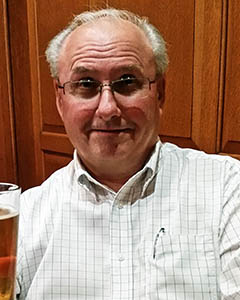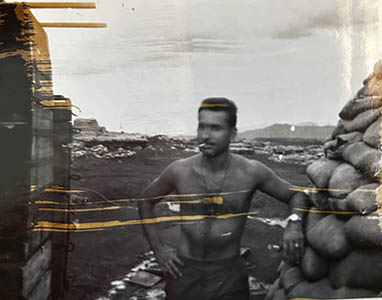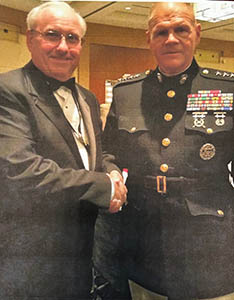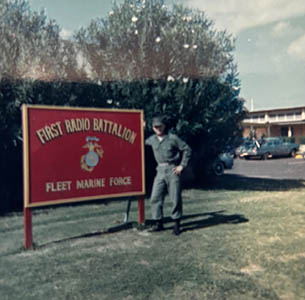Marines Vietnam Era Tinley Park, IL Flight date: 07/24/24
By Ginny Williamson, Honor Flight Chicago Veteran Interview Volunteer
Tom Kelly grew up in Oak Lawn, then moved to Chicago where his father was a Chicago police officer. Tom was the middle child of 3. There were family members who also served in the military. His father was in Italy in WW II, an airline mechanic in the Army Air Corps. Tom’s uncle was part of the Normandy invasion on a landing vehicle. His vehicle tipped over and he was helped up by a friend. His uncle made it through the war. Along with many others, Tom calls those who served in World War II the greatest generation.
In June 1965, Tom graduated from Bogan high school. The draft was going on. He and his classmate thought, “If we don’t go to college right away, we’ll probably get drafted.” As soon as they got their draft notices, they decided to go into the Marines. They thought as kids, if we got drafted they would go to Vietnam. They thought, “When we go to Vietnam, we can kick ass instead of getting our asses kicked.”
In November 1966, Tom and his friend planned to go to the Marine recruitment office. The night before going, he and a friend got into a fight with some other guys. When they arrived at the recruitment office, the recruiter saw Tom’s black eye and broken nose and asked him what happened. After telling the recruiter what happened the night before, the recruiter said, “We like tough guys.” He then proceeded to tear up Tom’s Army draft notice and said, with a wry smile, “You guys are mine.”
Tom did his boot camp at MCRD (Marine Corps Recruit Depot) in San Diego, California. At boot camp, the National Security Agency (NSA) came out to interview guys and selected 2 – Tom and one other. They gave them several tests, including a Morse Code test. The North Vietnamese used the same Morse Code so the US could intercept. Tom was at Morse Code training for 2 months.
January 1967, he and his friend graduated from boot camp. After a 20-day leave, they were to go to a school in Pensacola, but that location was full. So, Tom ended up at Ft. Devens in Massachusetts. For his Morse Code training, they were started off with the basics – learning to recognize the letters of the alphabet. As they worked their way through the alphabet, during the classes, they had to yell out each letter: A – Alpha! Once they learned the characters, they started them on 5-letter groups. This was all done on manual typewriters.
There were 75 guys in Tom’s training group. They were tested after their first one to two weeks of training. The instructor called out 10 names. “You guys scored 100% on your test.” Tom was one of the 10. For the next test, the instructor called out 8 names, with 100% scores. And by the end of the testing, Tom was the only one with a score of 100%.
Near the end of training, Tom was AOG (ahead of the game). He progressed fast. When they scored 30 words per minute, they would pass. But when Tom got to 18 words per minute, he got stuck. At that time, they announced they needed 10 guys to go to Hawaii. Alternatively, they would go to Camp Lejeune. No one wanted to go to Camp Lejeune.
Guys were starting to pass Tom up. His motivation was Hawaii. So, he started to get better and then finally got to 30 words per minute. They had to take a typing test to pass the course, but Tom had never typed before. He admitted that he memorized the words, so that he could type faster. He passed. He became a Special Radio Operator Morse Intercept – Top Secret Clearance.
Tom was selected for assignment in Hawaii in late spring 1967, planned for 9 months until January 1968. One morning, out of the blue, they hear ‘We’re moving out. Let’s go.” He later learned that they were bringing back the Pueblo – an intelligence ship that was captured by the North Koreans in Korea. (They claimed that the ship was in North Korean territory.) They came to Hawaii to debrief them after being captured for one year. So space needed to be made to accommodate the Pueblo guys, and Tom couldn’t go to Hawaii.
As he packed up, Tom put everything into his sea bag. They boarded a C130 plane, loaded up 2 Jeeps and ‘pigs” (intelligence radio equipment, PRD1). They got to Wake Island, then on to Guam, and then to Vietnam – their final destination. They landed in Da Nang, assigned to Hill 327 just outside of Da Nang. In that area, only Hill 327 had intelligence.
A first radio battalion truck picked them up and took them to the hill at night. In Da Nang, the officer called out names; these guys were sent out to other areas. He and his buddy thought, ‘We’re not staying here, are we?” The officer came back and said, “Kelly, you’re going Khe Sanh.” No one wanted to go Khe San; there were 30,000 to 50,000 North Vietnamese there.
They needed to find a helicopter to take them to Khe Sanh. Each of the helicopter pilots he approached replied with, “We’re not going in there; it’s too hot.” This went on all day. On the second day, the same thing. On day 3, at the end of the day, Tom found a helicopter pilot who would take them. He and his buddy boarded the helicopter with a bunch of other Marines.
In Khe Sanh, two planes had already been shot down. Only helicopters could get in. The Marines were told, “You guys are going to have to jump off. He’s not going to set down. They’re shooting at us.” And, they were told that when they get off the helicopter, they better be running. After Tom and the others jumped out, they later went back to get their bags that were dumped. A Sergeant came out to pick them up in a truck.





On Day 1 in Khe San, they were given a tour of the bunkers. Four rockets came in. “Get down!” The officer asked, “Didn’t you hear the pops?” Tom and the others learned, you hear the pops and know there was incoming. During this time was the Tet Offensive – the North Vietnamese hit all kinds of military bases in Khe Sanh.
During the tour of the bunker, they saw a sign that read, “Welcome to Khe Sanh. Home is where you dig it.”
While they were in Khe Sanh, they built a shower out of ammo boxes. They put water barrels on top and heated the water with a Bunson burner. A comfort in those days. At Khe Sanh, the supply tent was gone in a week. Tom lost his sea bag, and everything he had to his name. That left him with only one pair of utility pants and a couple of t-shirts for his tour in Khe Sanh.
And Khe Sanh was overridden with rats. They went hunting for rats and the MPs came out and asked who was shining the flash lights, who was lighting up the perimeter. All for hunting rats!
About 100 yards out of their base, they could see where the North Vietnamese were digging tunnels. The North Vietnamese surrounded the base, and they had shadow gunners coming through the base often.
The Marines had “Puff the Magic Dragon” (also called a “spooky”), a small combat plane used in WW II converted into a gun ship, mounted with small guns on them. The “Puff” gun ships shot 6,000 rounds per minute. They knew “Puff” was working out when they would see the red strafe from the gunship. “If it wasn’t for Puff, we would have been overrun. We would have been killed.”
In January 1968, the North Vietnamese hit their ammo dump and it exploded. In March 1968, the North Vietnamese sent in around 1300 rounds. Luckily, the bunkers on the base were secured. Only a few guys were hit, mostly when running through the base. One day, when Tom was walking through the compound and a round buzzed right by his ear, he thought “That had to be a sniper round.” He had to crawl back to the bunker. He was still walking around “like a dummy.”
In Khe Sanh, there were maps set up. Tom and the other Morse Interceptors had to go to the top of a mountain to get the best signals. The North Vietnamese only sent their messages in Morse Code. Using SRDF (short range direction finding), Tom on the other Morse Code interceptors could be on a mountain top and pinpoint the enemy locations to 250 to 500 yards. The LRDF (long range direction finding) was only done by air and not as accurate.
They set up four different radio units on four different mountains in Tom’s area. Each was manned by a Morse Code interceptor. Tom was at LZ Neville. He was picking up several messages while there. Referencing his Comas Book – a book with several pages on how to send messages to other Marine code interceptors – Tom would send a message to the other guys and let them know the location of the North Vietnamese. The North Vietnamese would send their messages, always coded, with a ‘dit dit dit dah’ (a a a d)’, and then the name of their unit. The North Vietnamese would send these messages over and over. Tom and his guys would pick up these messages and send them to the operations unit on base. Operations would then call in the fire missions to take out that location.
Before fire could be sent in on the North Vietnamese, they needed three lines of call-ins from the Morse Code interceptors to create a triangulated locator. This would give them the accuracy they needed to 250 to 500 yards.
Tom was one of the best Morse Code interceptors in Khe San; he called in more messages than any others. He and his group received the Naval Unit and Presidential Unit Citation for taking out enemy units.
In boot camp, Tom had trained with an M14. When he was handed the gun, he was told, “Go get the enemy.” He became an expert with the M14. When he got to Khe Sanh, he was issued an M16, which he had never used before. As Tom went to turn in his M14, he heard “Hey, Kelly.” It was the guy he signed up with in 1967. This guy had later been assigned to a unit with the Korean Marines.
Tom was at the base in Khe Sanh from January to June 1968. When they closed the base in June 1968, they blew up the bunkers. He then moved on to Vandergrift Marine Combat Base landing zone. They had to set up a bunker with 20 fellow Marines, only 9 of whom came from Khe San.
At Vandergrift, the highest threat there were the monsoons. Tom and his guys had to fill sandbags all the time. So, they built a sandbag filling machine to make this process quicker and easier. While there, one of his guys lost his ‘pig’ antenna. So, they went to take someone else’s. A couple of guys got caught as Tom and the rest went running through the elephant grass.
Tom’s service with the Marines was scheduled to end in November 1969. His tour in Vietnam was over in February/March 1969. But if they got out early, they would have been sent to Camp Lejeune. Remember, no one wanted to go to Camp Lejeune. At that time, if you had less than six months left in your service, you could go home. So, Tom extended a few months after March and was able to go home in June 1969.
For Tom, the most interesting part of his service was boot camp and Khe Sanh.
After his service, Tom attended McCormick Community College and then Loyola University in Chicago. He worked while going to school and received his Accounting and Business degree in 1997. He has attended several reunions over the years, the next one coming up in Tennessee in August 2024.
Tom never married, but has been with his partner Marie for over 30 years. They live in Tinley Park. Tom played 16” softball for over 40 years, until the age 62, and his team was inducted into the Chicago Softball Hall of Fame. Tom is retired and spends his days golfing and still working, at CVS.
Welcome aboard, Tom. Enjoy your day of honor. And thank you so very much for your years of service.


